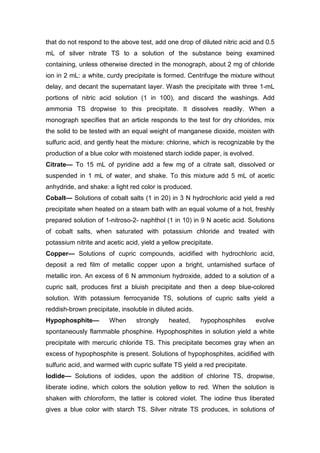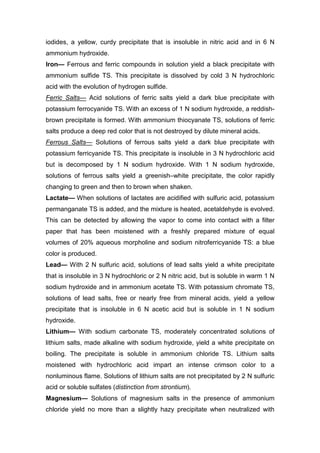This document provides identification tests for various chemical compounds and ions. It lists over 30 different substances and describes 1-2 chemical tests that can be used to identify each one. The tests identify compounds and ions based on characteristics of precipitates formed (such as color, solubility), gas evolved, or flame coloration. For example, it states that acetates produce ethyl acetate when warmed with sulfuric acid and alcohol, and that chlorides form a precipitate with silver nitrate that dissolves in ammonium hydroxide. The tests are intended to allow unambiguous identification of substances in accordance with pharmacopeial standards.
![191〉
〉
〉
〉 IDENTIFICATION TESTS—GENERAL
Under this heading are placed tests that are frequently referred to in the
Pharmacopeia for the identification of official articles. [NOTE—The tests are not
intended to be applicable to mixtures of substances unless so specified.]
Acetate— When acetic acid or an acetate is warmed with sulfuric acid and
alcohol, ethyl acetate, recognizable by its characteristic odor, is evolved. With
neutral solutions of acetates, ferric chloride TS produces a deep red color that is
destroyed by the addition of mineral acids.
Aluminum— With 6 N ammonium hydroxide, solutions of aluminum salts yield
a gelatinous, white precipitate that is insoluble in an excess of 6 N ammonium
hydroxide. 1 N sodium hydroxide or sodium sulfide TS produces the same
precipitate, which dissolves in an excess of either of these reagents.
Ammonium— Ammonium salts are decomposed by the addition of an excess
of 1 N sodium hydroxide, with the evolution of ammonia, recognizable by its
odor and by its alkaline effect upon moistened red litmus paper exposed to the
vapor. Warming the solution accelerates the decomposition.
Antimony— With hydrogen sulfide, solutions of antimony (III) compounds,
strongly acidified with hydrochloric acid, yield an orange precipitate of antimony
sulfide that is insoluble in 6 N ammonium hydroxide, but is soluble in
ammonium sulfide TS.
Barium— Solutions of barium salts yield a white precipitate with 2 N sulfuric
acid. This precipitate is insoluble in hydrochloric acid and in nitric acid. Barium
salts impart a yellowish-green color to a nonluminous flame that appears blue
when viewed through green glass.
Benzoate— In neutral solutions, benzoates yield a salmon-colored precipitate
with ferric chloride TS. In moderately concentrated solutions, benzoates yield a
precipitate of benzoic acid upon acidification with 2 N sulfuric acid. This
precipitate is readily soluble in ethyl ether.
Bicarbonate— See Carbonate.
Bismuth— When dissolved in a slight excess of nitric acid or hydrochloric acid,
bismuth salts yield a white precipitate upon dilution with water. This precipitate
is colored brown by hydrogen sulfide, and the resulting compound dissolves in a
warm mixture of equal parts of nitric acid and water.](https://image.slidesharecdn.com/191identificationtests-230220033329-ddd68c0d/85/191_Identification_tests-pdf-1-320.jpg)
![Bisulfite— See Sulfite.
Borate— To 1 mL of a borate solution, acidified with hydrochloric acid to litmus,
add 3 or 4 drops of iodine TS and 3 or 4 drops of polyvinyl alcohol solution (1 in
50): an intense blue color is produced. When a borate is treated with sulfuric
acid, methanol is added, and the mixture is ignited, it burns with a green-
bordered flame.
Bromide— Solutions of bromides, upon the addition of chlorine TS, dropwise,
liberate bromine, which is dissolved by shaking with chloroform, coloring the
chloroform red to reddish brown. Silver nitrate TS produces in solutions of
bromides a yellowish–white precipitate that is insoluble in nitric acid and is
slightly soluble in 6 N ammonium hydroxide.
Calcium— Solutions of calcium salts form insoluble oxalates when treated as
follows. To a solution of the calcium salt (1 in 20) add 2 drops of methyl red TS,
and neutralize with 6 N ammonium hydroxide. Add 3 N hydrochloric acid,
dropwise, until the solution is acid to the indicator. Upon the addition of
ammonium oxalate TS, a white precipitate is formed. This precipitate is
insoluble in 6 N acetic acid but dissolves in hydrochloric acid. Calcium salts
moistened with hydrochloric acid impart a transient yellowish-red color to a
nonluminous flame.
Carbonate— Carbonates and bicarbonates effervesce with acids, evolving a
colorless gas that, when passed into calcium hydroxide TS, produces a white
precipitate immediately. A cold solution (1 in 20) of a soluble carbonate is
colored red by phenolphthalein TS, while a similar solution of a bicarbonate
remains unchanged or is only slightly colored.
Chlorate— Solutions of chlorates yield no precipitate with silver nitrate TS. The
addition of sulfurous acid to this mixture produces a white precipitate that is
insoluble in nitric acid, but is soluble in 6 N ammonium hydroxide. Upon ignition,
chlorates yield chlorides, recognizable by appropriate tests. When sulfuric acid
is added to a dry chlorate, decrepitation occurs, and a greenish yellow-gas is
evolved. [Caution—Use only a small amount of chlorate for this test, and
exercise extreme caution in performing it. ]
Chloride— With silver nitrate TS, solutions of chlorides yield a white, curdy
precipitate that is insoluble in nitric acid but is soluble in a slight excess of 6 N
ammonium hydroxide. When testing amine (including alkaloidal) hydrochlorides](https://image.slidesharecdn.com/191identificationtests-230220033329-ddd68c0d/85/191_Identification_tests-pdf-2-320.jpg)



![Peroxide— Solutions of peroxides slightly acidified with sulfuric acid yield a
deep blue color upon the addition of potassium dichromate TS. On shaking the
mixture with an equal volume of ethyl ether and allowing the liquids to separate,
the blue color is found in the ethyl ether layer.
Phosphate— [NOTE—Where the monograph specifies the identification test for
Phosphate, use the tests for orthophosphates, unless the instructions specify
the use of the pyrophosphate tests or indicate that the product is to be ignited
before performing the test.] With silver nitrate TS, neutral solutions of
orthophosphates yield a yellow precipitate that is soluble in 2 N nitric acid and in
6 N ammonium hydroxide. With ammonium molybdate TS, acidified solutions of
orthophosphates yield a yellow precipitate that is soluble in 6 N ammonium
hydroxide. This precipitate may be slow to form. With silver nitrate TS,
pyrophosphates obtained by ignition yield a white precipitate that is soluble in 2
N nitric acid and in 6 N ammonium hydroxide. With ammonium molybdate TS, a
yellow precipitate that is soluble in 6 N ammonium hydroxide is formed.
Potassium— Potassium compounds impart a violet color to a nonluminous
flame, but the presence of small quantities of sodium masks the color unless
the yellow color produced by sodium is screened out by viewing through a blue
filter that blocks emission at 589 nm (sodium) but is transparent to emission at
404 nm (potassium). Traditionally, cobalt glass has been used, but other
suitable filters are commercially available. In neutral, concentrated or
moderately concentrated solutions of potassium salts (depending upon the
solubility and the potassium content), sodium bitartrate TS produces a white
crystalline precipitate that is soluble in 6 N ammonium hydroxide and in
solutions of alkali hydroxides and carbonates. The formation of the precipitate,
which is usually slow, is accelerated by stirring or rubbing the inside of the test
tube with a glass rod. The addition of a small amount of glacial acetic acid or
alcohol also promotes the precipitation.
Salicylate— In moderately dilute solutions of salicylates, ferric chloride TS
produces a violet color. The addition of acids to moderately concentrated
solutions of salicylates produces a white, crystalline precipitate of salicylic acid
that melts between 158 and 161 .](https://image.slidesharecdn.com/191identificationtests-230220033329-ddd68c0d/85/191_Identification_tests-pdf-6-320.jpg)

